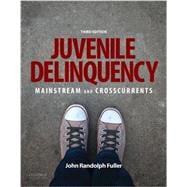Offering a highly analytical yet balanced approach, Juvenile Delinquency: Mainstream and Crosscurrents, Third Edition, encourages students to think critically about important real-world issues including the effects of inequality, race, class, and gender on juvenile delinquency and the juvenile justice system. Lively, engaging, and accessible, it is ideal for juvenile delinquency courses in both criminal justice and sociology departments.
FEATURES
A critical approach highlighting issues of race, class, gender, and inequality
Straightforward explanations of theory, history, gender, and international issues
"Crosscurrents" boxes on engaging and controversial challenges in the field
Rich pedagogical features including critical-thinking questions as captions for photos, "Focus on Ethics" boxes, and Learning Objectives that are keyed to the Summary tables
An online Ancillary Resource Center (ARC) containing an Instructor's Manual, a Computerized Test Bank, and PowerPoint-based lecture slides
An open-access Companion Website at www.oup.com/us/fuller that provides additional resources for students








